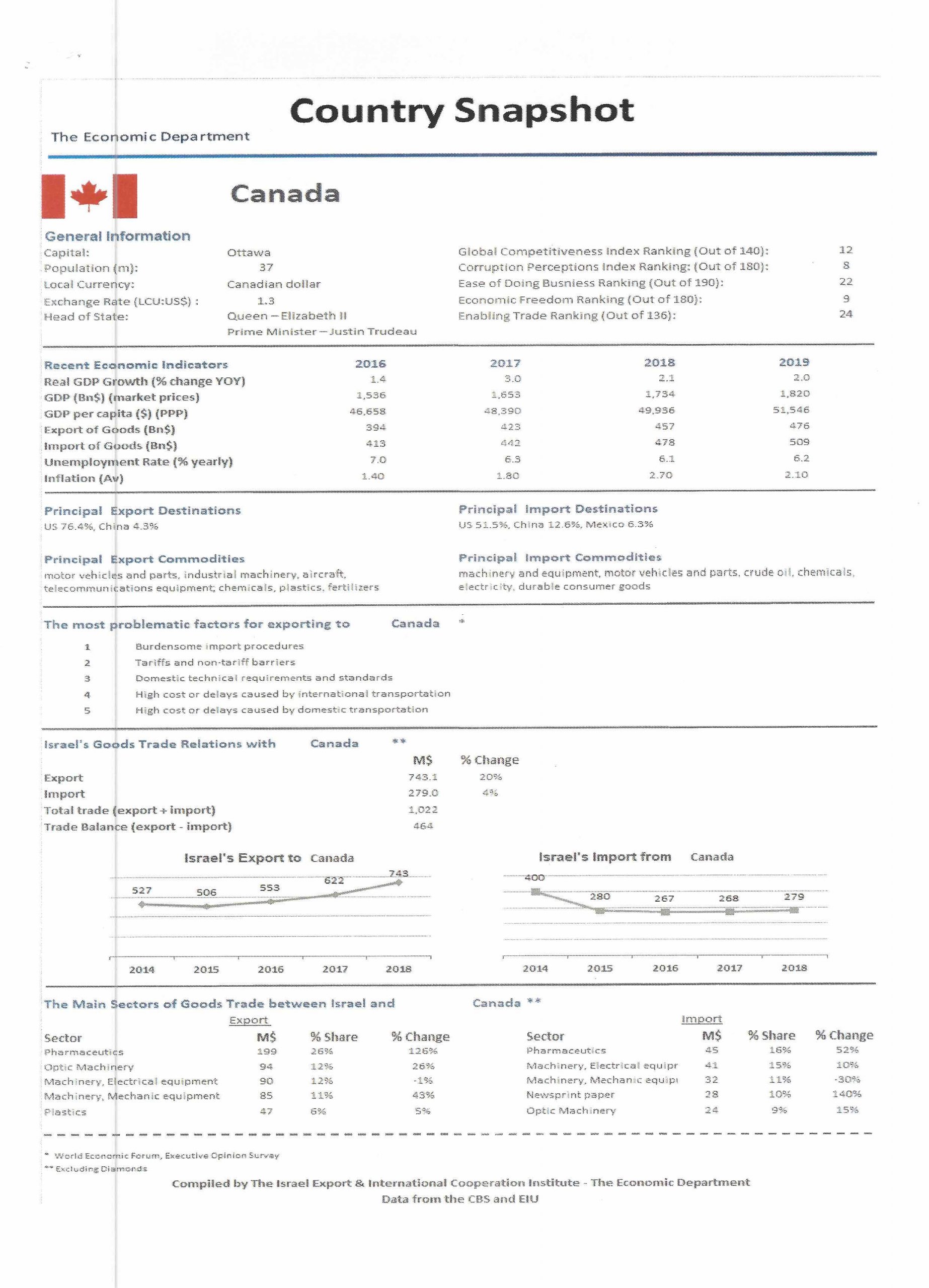Home » Why Canada?
why canada?
We are often asked why Canada. The reasons are many and varied. Canada is a large country, rich in raw materials with a stable and developed economy. It ranks tenth in overall GDP in 2016 among the industrialized countries (G7), and it exceeds seven of those countries in the GDP per capita. This means that, on average, Canadians will have disposable income to that enables them to purchase new imported goods and services. In addition, Canada’s population growth is the highest among the industrialized countries, so the potential consumer population with the means to purchase is growing over time.It is interesting to note that two-thirds of the population growth over the last five years is a product of immigration, meaning Canada is gaining a more diverse population that can support niche markets for international products. New opportunities and export deals are never easy, but Canada is definitely showing promising signs for businesses who consider it their next destination.
Also, the World Bank ranks Canada in 22nd place out of 190 countries in the ease of doing business index.
If you already feel the urge to know more , you are welcome to click on the following links for more datails.
Canada-Israel Free Trade Amending Protocol 2018
On May 28th, 2018, Canada and Israel signed the Canada-Israel Free Trade Amending Protocol 2018, amending the Canada-Israel Free Trade Agreement (CIFTA or Agreement) that originally came into force on January 1, 1997. At Canada’s request for an upgrade of the 1997 agreement, the countries started to negotiate in February 2014. Since then, intra-country trade has grown significantly – from half a billion dollars to almost a billion dollars in 2017. The volume of imports of goods from Canada to Israel in 2017 is estimated at $ 2.299 million and exports from Israel to Canada at $ 4.663 million.
Industrial products were tax-exempt under the original agreement and the purpose of the updated agreement was to extend the benefits to other areas such as agriculture and food. the goal has been reached in both directions: Exports to Canada: Out of 1646 lines of customs (similar products or product groups) 1073 will be duty-free for Israeli exporters to Canada.
Imports into Israel: Out of a total of 1430 customs lines 799 customs lines will be tax-exempt and 106 will receive partial tax relief on exporters from Canada upon entering Israel.
The original clauses were extended to include exporters who have not met the terms of the original agreement. For example, the updated agreement includes for the first time a chapter on small and medium businesses. As part of this chapter, the parties have agreed on cooperation, which includes identifying ways to support small and medium-sized businesses on both sides, to take advantage of the commercial opportunities afforded by the agreement.
The amending protocol creates flexibility by the new possibility to make minimal adjustments in some countries without losing the source status. This creates the right infrastructure for the global operations of the factories and expands the maneuverability of Israeli exporters. In addition, an outline is being developed for promoting cooperation with Jordan, opening up the integration of Israeli and Jordanian industries with exports to Canada.
הסכמי סחר ישראל קנדה
תאריך פרסום: 02.09.2019: ההסכם המשודרג לאזור סחר חופשי בין ישראל לקנדה נכנס לתוקף
נתוני משרד הכלכלה
אוכלוסיה: 35.2 מליון איש , מרביתם מרוכזים בקרבת הגבול עם ארה”ב.
שטח: 9,971,000 קמ”ר (פי 450 משטחה של ישראל).
10 פרובינציות ו-3 טריטוריות (שטחי ענק בצפון קנדה, דלילים באוכלוסיה).
בעשור האחרון מתחזק מטבע הדולר הקנדי, CAD.
קנדה מדורגת מס’ 14 בעולם בתמ”ג לנפש ושומרת על מגמת צמיחה יציבה מ-2011.
תמ”ג לנפש: 51,911 $ (US)
תמ”ג לנפש (PPP): 43,253$ (US)
קצב צמיחה: 2.2%
תחזית קצב הצמיחה: לשנים 2015-1019 2.2%
שירותים מהווים כ69% מה GDP , תעשייה 28% מה GDP
ענפי תעשייה עיקריים
- מגזר השירותים המגזר הגדול והמפותח ביותר בכלכלה הקנדית – מעסיק 75% מכוח העבודה ותורם שני שלישים מהתוצר. פיננסים, ביטוח ונדל”ן מהווים חלק מרכזי בו. הסקטור הפיננסי של קנדה מדורג במקום הראשון בדירוג ההשקעות של מודי’ס.
- מערכת בנקאית המערכת הבנקאית הקנדית נחשבת לאחת החזקות בעולם ושרדה בהצלחה גם את המשבר הפיננסי העולמי ב-2008.
- אנרגיה ואוצרות טבע קנדה היא מעצמת נפט בהתהוות – היא עתודת הנפט השלישית בגודלה בעולם והשישית בהפקתו. בנוסף, היא המפיקה השלישית בעולם של גז טבעי והשנייה בהפקת אוראניום. קנדה היא גם הספקית הראשית של ארה”ב בתחום האנרגיה (שמנים, ז, אוראניום, וחשמל). מתוך כלל הייצוא של קנדה ב-2013 (שעמד על 458 מיליארד דולר), סקטור האנרגיה ואוצרות הטבע הוא המשמעותי ביותר – כ-160 מיליארד דולר ייצוא בשנה זו (מתוכם כ-111 מיליארד דולר רק נפט וגז).
- ענף הרכב קנדה היא המדינה ה-16 בגודלה בעולם בייצור הרכב, כאשר 90% מהייצור מיועד לייצוא (בעיקר לארה”ב). הענף מהווה 12% מכלל הייצור הקנדי ו-9% מהייצוא הקנדי (44 מיליארד דולר ב-2013).
- תעשיית הייעור והעץ הייעור בקנדה מהווה 10% מהיערות בעולם כולו ומאפשר תעשייה חזקה בתחום (ייצור מוצרי עץ מלא, ייצור מוצרי עיסת נייר, כריתת עצים). מדובר במרכיב משמעותי ביותר בתמ”ג הקנדי.
- חקלאות גידול בעלי חיים, יבולים (חיטה, שעורה זרעים, פירות וירקות) וגידול אורגני מהווים חלק נכבד מענף החקלאות בקנדה. קנדה היא יצואנית התבואה השנייה בגודלה בעולם, אחרי ארה”ב. כמו כן, גם לתעשיית העופות (ייצוא ל-86 מדינות) ולמשק החלב תפקיד חשוב. בשנים האחרונות חל גידול רב בביקוש לחקלאות אורגנית, עד כדי קושי לספק את הסחורה.
- התעשייה האווירית והחלל קנדה היא יצרנית מובילה בעולם של חלקי מטוסים, תקשורת ומערכות אלקטרוניות למטוסים. היצוא בתחום זה מהווה מעל 80% מההכנסות השנתיות של התעשייה (שהן 22 מיליארד דולר).
- מכונות וציוד עיקר הפעילות במתכות, מכונות מנועים וטורבינות. ייצוא של כ-10 מיליארד דולר ב-2013.






